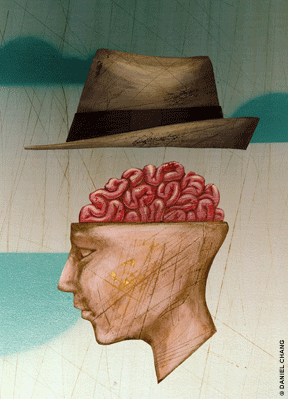
Class of ’73 | “I really don’t think it’s an exaggeration to suggest that we’re now witnessing an extraordinary sea change in how we think of mental illnesses like schizophrenia,” says Dr. Daniel Weinberger M’73, who has spent the past 27 years as a research scientist at the National Institute of Mental Health (NIMH) in suburban Washington.
Weinberger’s NIMH team made headlines last April with the announcement that it had managed to uncover the complex chemistry at work when a flawed gene (called “neuregulin-1”) helps create conditions that can result in schizophrenia.
“I don’t think there’s any doubt that our growing ability to understand the genetic factors involved in mental illness will soon begin to revolutionize our approach to treating devastating ailments like schizophrenia and bipolar disorder,” he says. “But that’s only part of the story. Because it’s also true that these new genetic tools are beginning to produce a similar kind of sea change in psychiatry. We’ve known for a hundred years—from the classic ‘adoption studies’ of researchers like Seymour Kety [C’36 M’40 Hon’65] at Penn’s medical school—that mental illness runs in families. But now, for the first time ever, genetic research is uncovering the actual molecular mechanisms that are responsible for the fact that illnesses like schizophrenia are handed down from one generation to the next.”
According to Weinberger, whose high-powered team of about 60 NIMH scientists and graduate students has pinpointed half a dozen genes associated with brain disorders since the data resources of the Genome Project began coming online in the mid-1990s, the new genetic studies of mental illness will soon “completely change” psychiatry.
“It’s now evident that these ‘objective’ findings about the biochemistry of mental illness are going to bring psychiatry back into the mainstream of medical science,” says Weinberger, who is also director of the NIMH’s recently formed Genes, Cognition and Psychosis program. “And that’s a wonderfully exciting development, obviously. These recent breakthroughs will change the playing field for psychiatry, because genes are not about hallucinations and delusions [symptoms of mental illness in patients]. Genes are about cell biology and molecular mechanisms—and so we are now seeing all kinds of cell biologists and biochemists who are eager to study genes related to psychiatry. I’ve been working for more than two decades as a researcher on schizophrenia, and I think this is the most exciting time I’ve ever lived through.”
His career has not lacked for excitement. After earning his Penn medical degree in 1973, Weinberger went on to complete a residency in psychiatry at Harvard and another one in neurology at George Washington University. By the early 1980s, he was already a rising star at the federally operated, $600 million-a-year NIMH. Primarily interested in the causes and biochemical mechanisms of schizophrenia, Weinberger spent a decade helping to organize and direct interdisciplinary teams that explored state-of-the-art brain-imaging systems designed to pinpoint chemical reactions in mentally ill patients.
In recent years, as chief of the Clinical Brain Disorders Branch at the NIMH, Weinberger specialized in brain-imaging studies and postmortem analysis of brain tissue from deceased mental patients in order to uncover the mechanisms involved in both schizophrenia and bipolar disorder. But his team’s latest investigations—such as the high-profile probe of the schizophrenia-linked neuregulin-1 gene earlier this year—have focused almost entirely on genetics, and it now seems likely that he’ll spend the rest of his NIMH career directing research on the increasingly apparent links between the human genome and brain disorders such as schizophrenia.
“I’m convinced that we’re going to wind up concluding that, ultimately, genetics are the key factor in the development of schizophrenia,” he says. “This is extremely exciting for those of us who work in the field. You have to remember that we still don’t really know what mental illness is. We know a lot about how it looks in a patient, and we know a lot about how it feels. But we have never known what it is at the biochemical level. And now the genome is changing that, right in front of our eyes. The genes we’re studying are absolutely the first objective clues about what really goes on at the very basic level of cell biology.”
For Weinberger, the dramatic breakthroughs can’t come soon enough. “The reality is that there’s still a very large population of very ill people out there,” he says.
“Many of these patients are not being adequately treated, and in many cases the resources aren’t available to manage the impact of the illness. The sooner we can identify the complex genetic processes at work in brain disorders, the sooner we’ll be able to help suffering patients.”
—Tom Nugent




